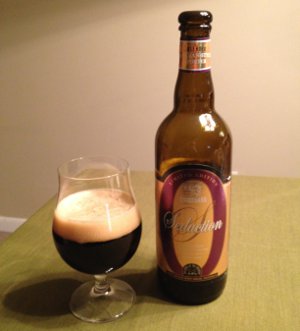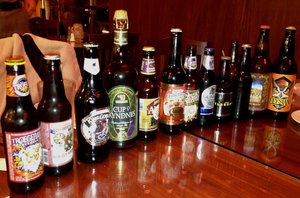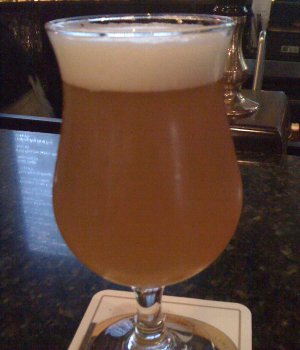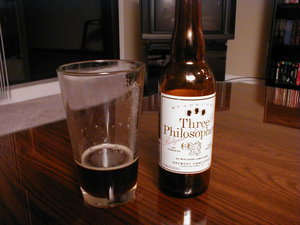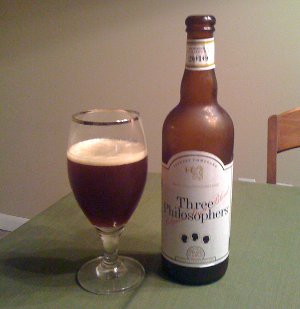Since I’m drinking hard to classify beers, let’s try this one on for size: A Traditional Belgian-style Scotch Ale. How can such a mashup be “traditional” you ask? What’s that? You didn’t ask? Well, too bad, because I’m going to wax philosophic on the topic for a while and you’re going to like it. Or not. I’m not your mother.
Where was I? Ah yes, the historical and beertastic relationship between the Scottland and Belgium, as laid out on the label of this beer:
The Belgian-Scotch brewing connection dates to World War I, when thousands of Scotsmen spent years in Belgium. To satisfy their new customers, Belgian brewers learned to brew Scotch-style ales, and the style became a new and significant part of the Belgian brewing tradition.
As the Aleheads note, this sounds more like marketing fluff than an attempt to carry on time-honored traditions. However, after looking into this a bit, it seems like there actually is a Belgo-Scotch connection dating back to WWI and involving Brouwerij Duvel Moortgat (which is notable in that they’re the parent company of Ommegang). Apparently a great deal of British soldiers brought their own beer over to Belgium during the Great War, and thus even the locals began to crave British styles, especially Scottish brews. To celebrate the end of the war, Moortgat brewed a special “Victory Ale” that was apparently dark, hefty, and malt-focused (just like Scotch Ales). Legend has it that folks referred to it as “a devil of a beer”, so Moortgat renamed the beer Duvel1 (which is Flemish for “Devil”). As peacetime trade was restored, imported Scotch ales became all the rage in Belgium.
Albert Moortgat had spent considerable time in Britain learning the intricacies of ale brewing. When he returned to Belgium, he brought with him a cache of bottle-conditioned McEwan’s Scotch ale. Each bottle was a treasure trove of viable, alien microorganisms. In his zeal to create a beer that was similar to the Scotch versions lapping up market share, Moortgat decided that the amalgam of yeast in the McEwan’s was worth investigating. He enlisted the help of none other than Jean De Clerck, the preeminent brewing scientist, pioneer of yeast isolation and characterization, and prestigious member of the Faculty of Brewing at Leuven University.
If you’ve ever spent time reading about beer history, especially that of eccentric Belgian brewers, the name Jean De Clerck will be immediately familiar. Dude is a legit legend in the brewing community, and if you like Trappist or Belgian beer styles, you owe the man a debt of gratitude. Anywho, with the help of De Clerck, Moortgat was making distinctive Beglo-Scotch ales in the 1930s.
So as it turns out, Ommegang really wasn’t blowing smoke up our arses when they made this beer. Indeed, of all the breweries out there, they may be the one most uniquely qualified to tackle such a historically-based brew. I suspect this beer, brewed with heather tips and a “wee bit” of smoked malt, isn’t quite an exact replica of what Duvel was making in the 30s, but their heart is in the right place. And while I have no basis for making such a claim2, I’ll go ahead and say that there’s a chance that Ommegang’s house yeast is distantly related to Duvel’s De Clerck strains. Or not.
One last thing before we get to the boring tasting notes, which is the name of the beer. It’s apparently derived from a line in Scottish poet Robert Burns’ infamous New Years anthem Auld Lang Syne: “For auld lang syne, my jo, For auld lang syne, We’ll tak a cup o’ kindness yet, For auld lang syne.” No idea why Ommegang decided to spell “kindness” with a “y” and only one “s”, but I’m guessing it has something to do with those wacky foreigners and their silly languages and dialects getting all mixed up and impossible to translate, like Qwghlmian3. Alrighty then, since I’ve gone from wild and irresponsible speculations on history to insulting foreigners, I guess I should just get on with the drinking:
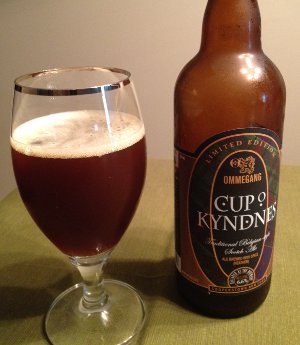
Ommegang Cup O Kyndnes – I suppose I should also note that this beer is almost 2 years old at this point. It was brewed and packaged in 2010, and I actually bought a half-case of the stuff (only 6 bottles, but the stupid PA case law actually worked in my favor this time, as this beer has aged rather well).
Pours a dark brown color with an amber hue and a finger or so of light colored head. Smells of rich, sweet malts of the darkish crystal variety with a little spice and maybe even some fruitiness apparent. Taste is sweet, but not quite as richly flavored as the nose would have you believe. This isn’t to say it tastes bad though, it’s really quite nice and well balanced, with a big spicy component emerging in the finish. I have to admit that I’m not entirely sure I can pick out heather, but the beer does have a distinctly Scottish feel to it. Also, I’ve never detected any smoke in this beer, so I’m guessing it’s a very small and delicate amount (I wasn’t really looking for it though, so who knows). I’m told that smoked malt acts as a preservative and can extend the life of a beer, and given my experience, that may be happening here. Mouthfeel starts off velvety smooth, but the carbonation and spice seem to pick up steam through the taste, finishing with a stronger kick than expected. Relatively dry, but very well balanced. I have to say, the years have been kind to this beer. I didn’t quite love this as much the first couple times I had it, but it’s really hitting the spot right now. Very nice beer. When I first had it, I would have awarded it a B or B+, but like I said, this particular bottle struck a nerve, so it gets an A-
Beer Nerd Details: 6.6% ABV bottled (750 ml caged and corked). Drank out of a goblet on 6/29/12. Packaged on 8/2/10. Best by 8/2/12.
Ommegang continues to be one of my favorite breweries. This particular beer is a weird case, in that I just happened to pick up a sixer of the stuff on a whim about a year and a half ago (this is something I probably wouldn’t do these days) and while I liked it a lot, it wasn’t something that really struck me as fantastic until now… then again, the bottle sez this is best by 8/2/12, so maybe I just caught it at the height of its conditioning or something. It makes me wonder how accurate reviewing of single bottles can really be, but that’s a discussion for another time.
1 – Of course, this dark “Victory Ale” that became “Duvel” does not resemble what’s known as Duvel these days (which is light colored and maybe even a bit tart). But that is a long tale for another day. Or the article I linked to…
2 – If I were a historian, this claim would be downright irresponsible and Martyn Cornell would strike me down in righteous fury and vengeance. Fortunately, I’m just a random dude on the internet and my 3 readers probably take everything I say with a grain of salt.
3 – “…everyone hears it a little differently. Like just now–they heard your Outer Qwghlmian accent, and assumed you were delivering an insult. But I could tell you were saying that you believed, based on a rumor you heard last Tuesday in the meat market, that Mary was convalescing normally and would be back on her feet within a week.”
“I was trying to say that she looked beautiful,” Waterhouse protests.
“Ah!” Rod says. “Then you should have said, ‘Gxnn bhldh sqrd m!'”
“That’s what I said!”
“No, you confused the mid-glottal with the frontal glottal,” Rod says.
“Honestly,” Waterhouse says, “can you tell them apart over a noisy radio?”
“No,” Rod says. “On the radio, we stick to the basics: ‘Get in there and take that pillbox or I’ll fucking kill you.’ And that sort of thing.”
Before much longer, the band has finished its last set and the party’s over. “Well,” Waterhouse says, “would you tell Mary what I really did mean to say?”
“Oh, I’m sure there’s no need,” Rod says confidently. “Mary is a good judge of character. I’m sure she knows what you meant. Qwghlmians excel at nonverbal communication.”

